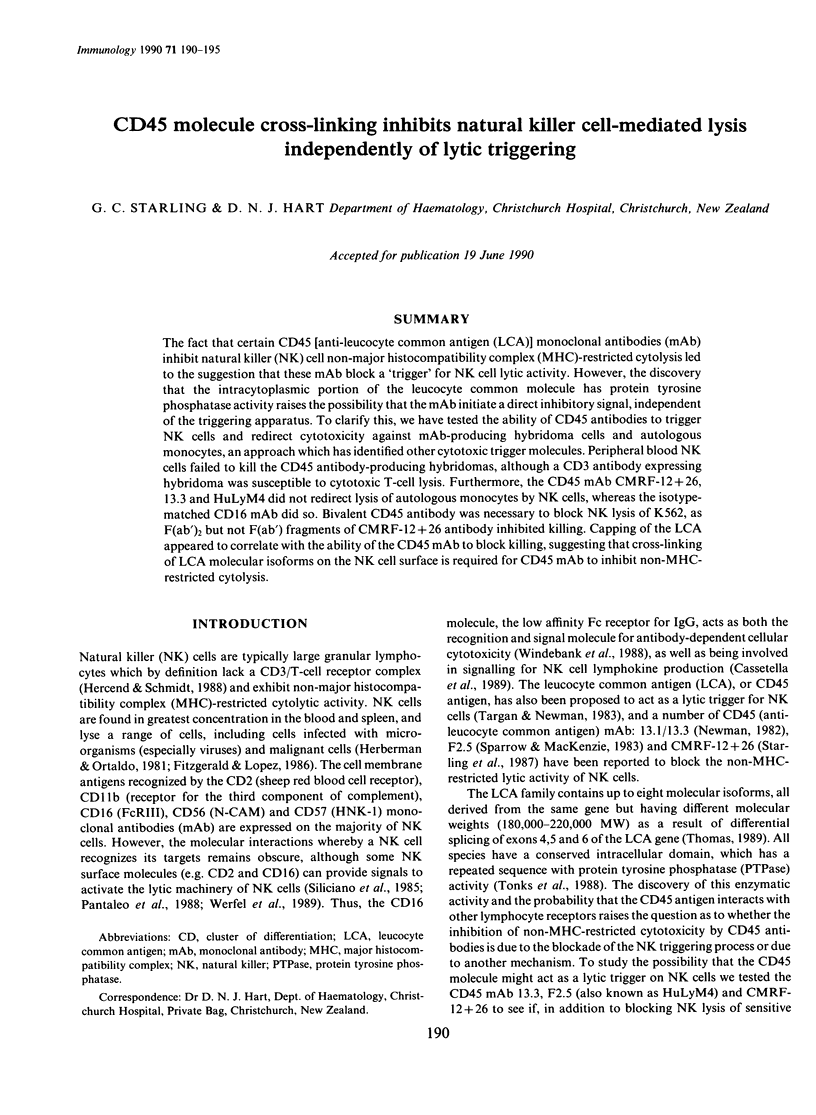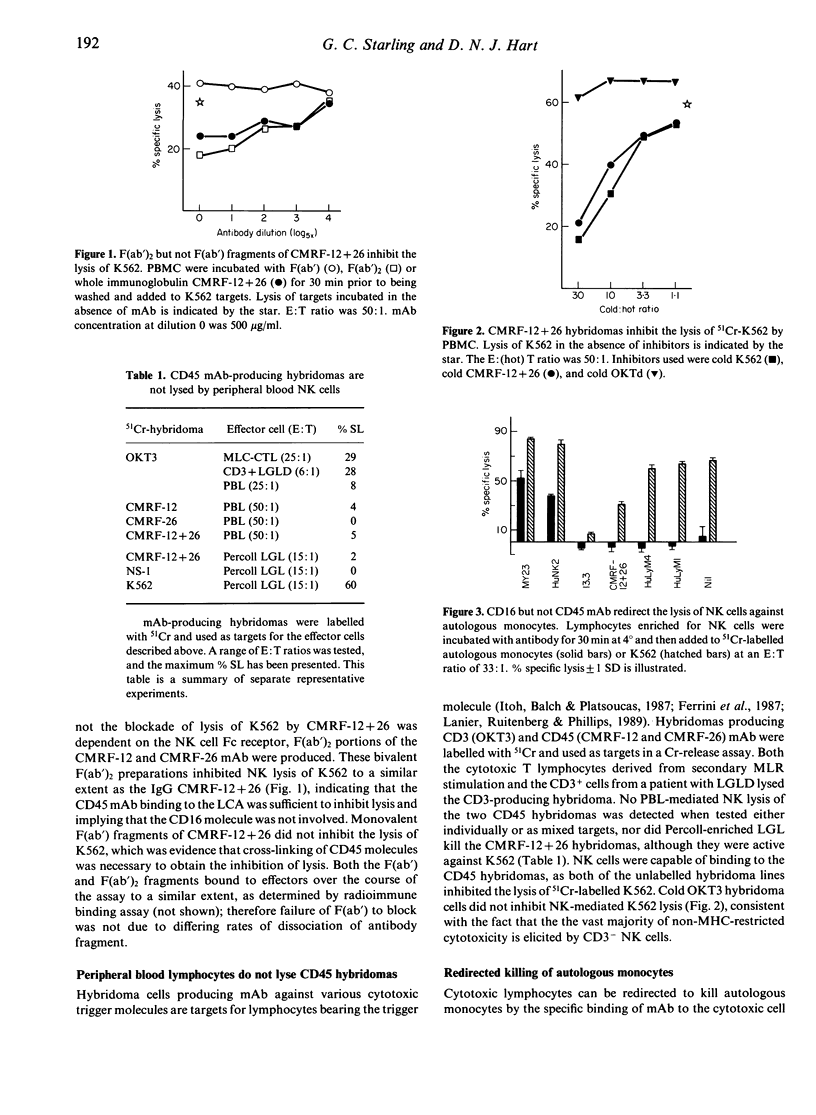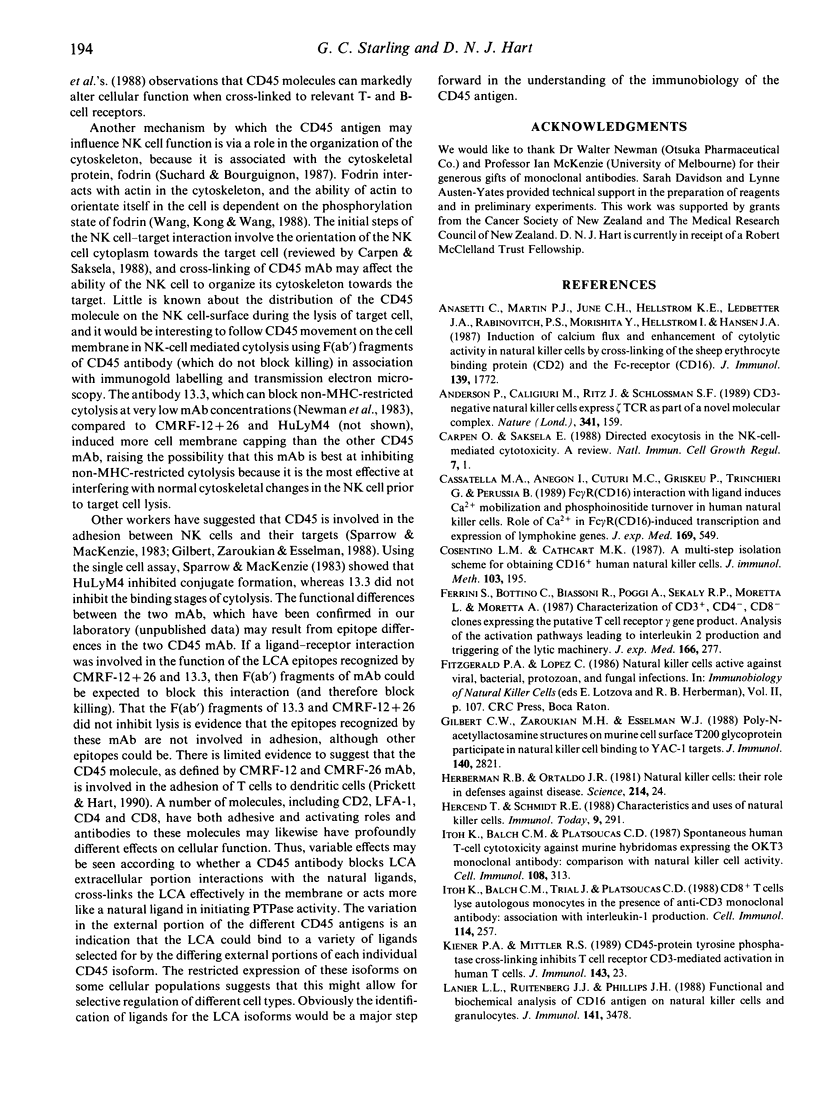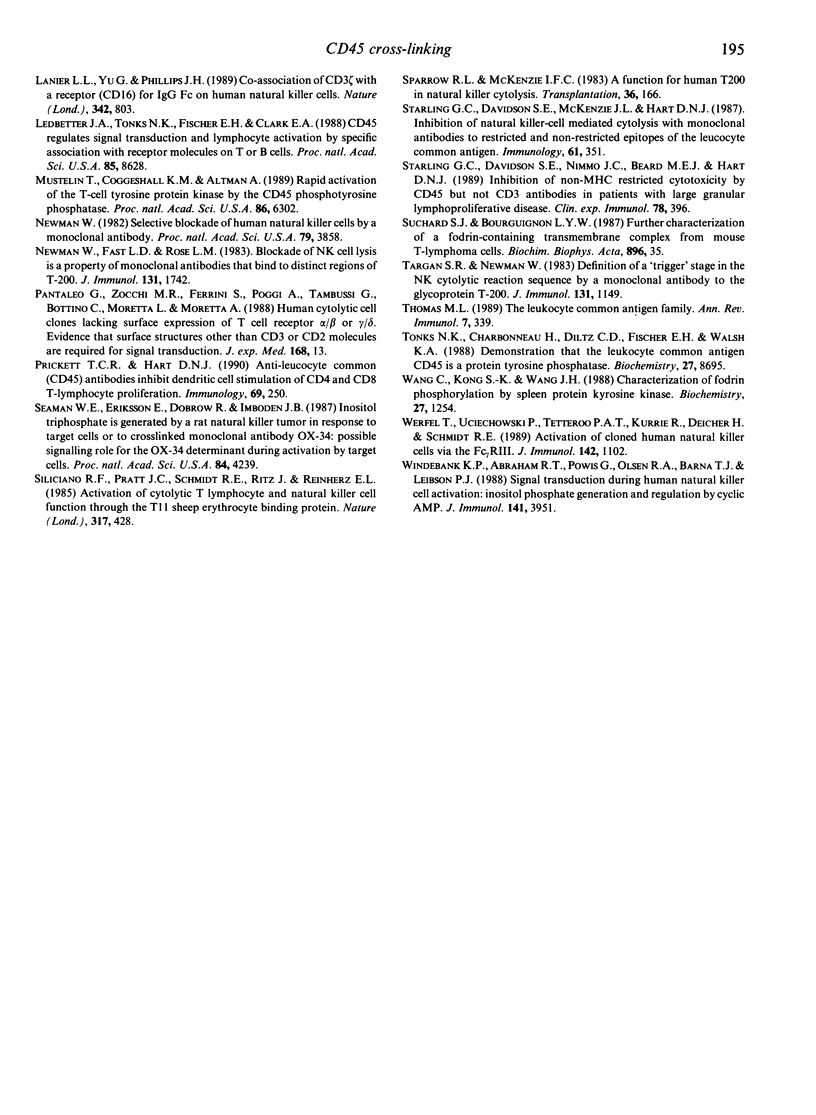Abstract
The fact that certain CD45 [anti-leucocyte common antigen (LCA)] monoclonal antibodies (mAb) inhibit natural killer (NK) cell non-major histocompatibility complex (MHC)-restricted cytolysis led to the suggestion that these mAb block a 'trigger' for NK cell lytic activity. However, the discovery that the intracytoplasmic portion of the leucocyte common molecule has protein tyrosine phosphatase activity raises the possibility that the mAb initiate a direct inhibitory signal, independent of the triggering apparatus. To clarify this, we have tested the ability of CD45 antibodies to trigger NK cells and redirect cytotoxicity against mAb-producing hybridoma cells and autologous monocytes, an approach which has identified other cytotoxic trigger molecules. Peripheral blood NK cells failed to kill the CD45 antibody-producing hybridomas, although a CD3 antibody expressing hybridoma was susceptible to cytotoxic T-cell lysis. Furthermore, the CD45 mAb CMRF-12 + 26, 13.3 and HuLyM4 did not redirect lysis of autologous monocytes by NK cells, whereas the isotype-matched CD16 mAb did so. Bivalent CD45 antibody was necessary to block NK lysis of K562, as F(ab')2 but not F(ab') fragments of CMRF-12 + 26 antibody inhibited killing. Capping of the LCA appeared to correlate with the ability of the CD45 mAb to block killing, suggesting that cross-linking of LCA molecular isoforms on the NK cell surface is required for CD45 mAb to inhibit non-MHC-restricted cytolysis.
Full text
PDF





Selected References
These references are in PubMed. This may not be the complete list of references from this article.
- Anasetti C., Martin P. J., June C. H., Hellstrom K. E., Ledbetter J. A., Rabinovitch P. S., Morishita Y., Hellstrom I., Hansen J. A. Induction of calcium flux and enhancement of cytolytic activity in natural killer cells by cross-linking of the sheep erythrocyte binding protein (CD2) and the Fc-receptor (CD16). J Immunol. 1987 Sep 15;139(6):1772–1779. [PubMed] [Google Scholar]
- Anderson P., Caligiuri M., Ritz J., Schlossman S. F. CD3-negative natural killer cells express zeta TCR as part of a novel molecular complex. Nature. 1989 Sep 14;341(6238):159–162. doi: 10.1038/341159a0. [DOI] [PubMed] [Google Scholar]
- Carpén O., Saksela E. Directed exocytosis in the NK-cell-mediated cytotoxicity. A review. Nat Immun Cell Growth Regul. 1988;7(1):1–12. [PubMed] [Google Scholar]
- Cassatella M. A., Anegón I., Cuturi M. C., Griskey P., Trinchieri G., Perussia B. Fc gamma R(CD16) interaction with ligand induces Ca2+ mobilization and phosphoinositide turnover in human natural killer cells. Role of Ca2+ in Fc gamma R(CD16)-induced transcription and expression of lymphokine genes. J Exp Med. 1989 Feb 1;169(2):549–567. doi: 10.1084/jem.169.2.549. [DOI] [PMC free article] [PubMed] [Google Scholar]
- Cosentino L. M., Cathcart M. K. A multi-step isolation scheme for obtaining CD16+ human natural killer cells. J Immunol Methods. 1987 Nov 5;103(2):195–204. doi: 10.1016/0022-1759(87)90290-0. [DOI] [PubMed] [Google Scholar]
- Ferrini S., Bottino C., Biassoni R., Poggi A., Sekaly R. P., Moretta L., Moretta A. Characterization of CD3+, CD4-, CD8- clones expressing the putative T cell receptor gamma gene product. Analysis of the activation pathways leading to interleukin 2 production and triggering of the lytic machinery. J Exp Med. 1987 Jul 1;166(1):277–282. doi: 10.1084/jem.166.1.277. [DOI] [PMC free article] [PubMed] [Google Scholar]
- Gilbert C. W., Zaroukian M. H., Esselman W. J. Poly-N-acetyllactosamine structures on murine cell surface T200 glycoprotein participate in natural killer cell binding to YAC-1 targets. J Immunol. 1988 Apr 15;140(8):2821–2828. [PubMed] [Google Scholar]
- Hercend T., Schmidt R. E. Characteristics and uses of natural killer cells. Immunol Today. 1988 Oct;9(10):291–293. doi: 10.1016/0167-5699(88)91317-5. [DOI] [PubMed] [Google Scholar]
- Itoh K., Balch C. M., Platsoucas C. D. Spontaneous human T-cell cytotoxicity against murine hybridomas expressing the OKT3 monoclonal antibody: comparison with natural killer cell activity. Cell Immunol. 1987 Sep;108(2):313–322. doi: 10.1016/0008-8749(87)90215-2. [DOI] [PubMed] [Google Scholar]
- Itoh K., Balch C. M., Trial J., Platsoucas C. D. CD8+ T cells lyse autologous monocytes in the presence of anti-CD3 monoclonal antibody: association with interleukin-1 production. Cell Immunol. 1988 Jul;114(2):257–271. doi: 10.1016/0008-8749(88)90320-6. [DOI] [PubMed] [Google Scholar]
- Kiener P. A., Mittler R. S. CD45-protein tyrosine phosphatase cross-linking inhibits T cell receptor CD3-mediated activation in human T cells. J Immunol. 1989 Jul 1;143(1):23–28. [PubMed] [Google Scholar]
- Lanier L. L., Ruitenberg J. J., Phillips J. H. Functional and biochemical analysis of CD16 antigen on natural killer cells and granulocytes. J Immunol. 1988 Nov 15;141(10):3478–3485. [PubMed] [Google Scholar]
- Lanier L. L., Yu G., Phillips J. H. Co-association of CD3 zeta with a receptor (CD16) for IgG Fc on human natural killer cells. Nature. 1989 Dec 14;342(6251):803–805. doi: 10.1038/342803a0. [DOI] [PubMed] [Google Scholar]
- Ledbetter J. A., Tonks N. K., Fischer E. H., Clark E. A. CD45 regulates signal transduction and lymphocyte activation by specific association with receptor molecules on T or B cells. Proc Natl Acad Sci U S A. 1988 Nov;85(22):8628–8632. doi: 10.1073/pnas.85.22.8628. [DOI] [PMC free article] [PubMed] [Google Scholar]
- Mustelin T., Coggeshall K. M., Altman A. Rapid activation of the T-cell tyrosine protein kinase pp56lck by the CD45 phosphotyrosine phosphatase. Proc Natl Acad Sci U S A. 1989 Aug;86(16):6302–6306. doi: 10.1073/pnas.86.16.6302. [DOI] [PMC free article] [PubMed] [Google Scholar]
- Newman W., Fast L. D., Rose L. M. Blockade of NK cell lysis is a property of monoclonal antibodies that bind to distinct regions of T-200. J Immunol. 1983 Oct;131(4):1742–1747. [PubMed] [Google Scholar]
- Newman W. Selective blockade of human natural killer cells by a monoclonal antibody. Proc Natl Acad Sci U S A. 1982 Jun;79(12):3858–3862. doi: 10.1073/pnas.79.12.3858. [DOI] [PMC free article] [PubMed] [Google Scholar]
- Pantaleo G., Zocchi M. R., Ferrini S., Poggi A., Tambussi G., Bottino C., Moretta L., Moretta A. Human cytolytic cell clones lacking surface expression of T cell receptor alpha/beta or gamma/delta. Evidence that surface structures other than CD3 or CD2 molecules are required for signal transduction. J Exp Med. 1988 Jul 1;168(1):13–24. doi: 10.1084/jem.168.1.13. [DOI] [PMC free article] [PubMed] [Google Scholar]
- Prickett T. C., Hart D. N. Anti-leucocyte common (CD45) antibodies inhibit dendritic cell stimulation of CD4 and CD8 T-lymphocyte proliferation. Immunology. 1990 Feb;69(2):250–256. [PMC free article] [PubMed] [Google Scholar]
- Seaman W. E., Eriksson E., Dobrow R., Imboden J. B. Inositol trisphosphate is generated by a rat natural killer cell tumor in response to target cells or to crosslinked monoclonal antibody OX-34: possible signaling role for the OX-34 determinant during activation by target cells. Proc Natl Acad Sci U S A. 1987 Jun;84(12):4239–4243. doi: 10.1073/pnas.84.12.4239. [DOI] [PMC free article] [PubMed] [Google Scholar]
- Siliciano R. F., Pratt J. C., Schmidt R. E., Ritz J., Reinherz E. L. Activation of cytolytic T lymphocyte and natural killer cell function through the T11 sheep erythrocyte binding protein. Nature. 1985 Oct 3;317(6036):428–430. doi: 10.1038/317428a0. [DOI] [PubMed] [Google Scholar]
- Sparrow R. L., McKenzie I. F. A function for human T200 in natural killer cytolysis. Transplantation. 1983 Aug;36(2):166–171. doi: 10.1097/00007890-198308000-00011. [DOI] [PubMed] [Google Scholar]
- Starling G. C., Davidson S. E., McKenzie J. L., Hart D. N. Inhibition of natural killer-cell mediated cytolysis with monoclonal antibodies to restricted and non-restricted epitopes of the leucocyte common antigen. Immunology. 1987 Jul;61(3):351–356. [PMC free article] [PubMed] [Google Scholar]
- Starling G. C., Davidson S. E., Nimmo J. C., Beard M. E., Hart D. N. Inhibition of non-MHC-restricted cytotoxicity by CD45 but not CD3 monoclonal antibodies in patients with large granular lymphoproliferative disease. Clin Exp Immunol. 1989 Dec;78(3):396–401. [PMC free article] [PubMed] [Google Scholar]
- Targan S. R., Newman W. Definition of a "trigger" stage in the NK cytolytic reaction sequence by a monoclonal antibody to the glycoprotein T-200. J Immunol. 1983 Sep;131(3):1149–1153. [PubMed] [Google Scholar]
- Thomas M. L. The leukocyte common antigen family. Annu Rev Immunol. 1989;7:339–369. doi: 10.1146/annurev.iy.07.040189.002011. [DOI] [PubMed] [Google Scholar]
- Tonks N. K., Charbonneau H., Diltz C. D., Fischer E. H., Walsh K. A. Demonstration that the leukocyte common antigen CD45 is a protein tyrosine phosphatase. Biochemistry. 1988 Nov 29;27(24):8695–8701. doi: 10.1021/bi00424a001. [DOI] [PubMed] [Google Scholar]
- Wang C. Y., Kong S. K., Wang J. H. Characterization of fodrin phosphorylation by spleen protein tyrosine kinase. Biochemistry. 1988 Feb 23;27(4):1254–1260. doi: 10.1021/bi00404a027. [DOI] [PubMed] [Google Scholar]
- Werfel T., Uciechowski P., Tetteroo P. A., Kurrle R., Deicher H., Schmidt R. E. Activation of cloned human natural killer cells via Fc gamma RIII. J Immunol. 1989 Feb 15;142(4):1102–1106. [PubMed] [Google Scholar]
- Windebank K. P., Abraham R. T., Powis G., Olsen R. A., Barna T. J., Leibson P. J. Signal transduction during human natural killer cell activation: inositol phosphate generation and regulation by cyclic AMP. J Immunol. 1988 Dec 1;141(11):3951–3957. [PubMed] [Google Scholar]


